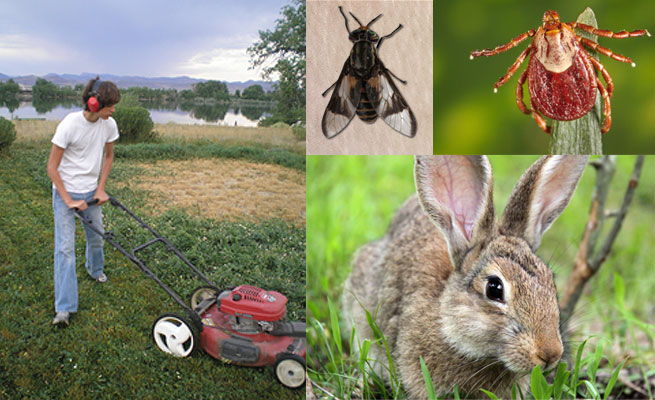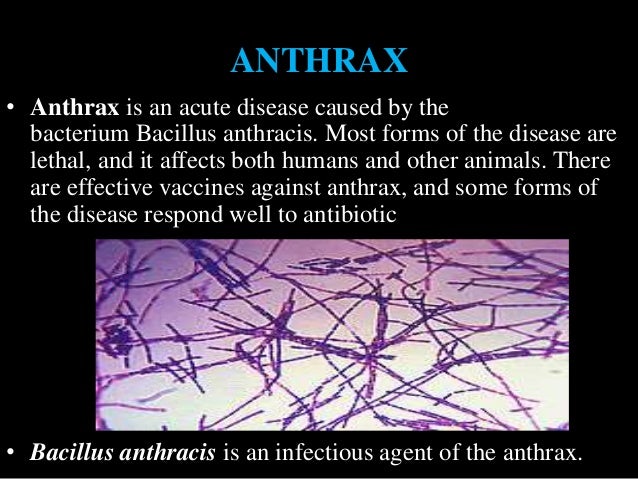6 Deadliest Biological Agents
An anthrax attack could take many forms. For example, it could be placed in letters and mailed, as was done in 2001, or it could be put into food or water. Anthrax also could be released into the air from a truck, building, or plane. This type of attack would mean the anthrax spores could easily be blown around by the wind or carried on people’s clothes, shoes, and other objects. It only takes a small amount of anthrax to infect a large number of people.
If anthrax spores were released into the air, people could breathe them in and get sick with anthrax. Inhalation anthrax is the most serious form and can kill quickly if not treated immediately. If the attack were not detected by one of the monitoring systems in place in the United States, it might go unnoticed until doctors begin to see unusual patterns of illness among sick people showing up at emergency rooms.
https://www.cdc.gov/anthrax/bioterrorism/threat.html
Smallpox
Smallpox is an extremely contagious and deadly virus for which there is no known cure. The last known case occurred in the United States in 1949 and due to worldwide vaccination programs, this disease has been completely eradicated. Smallpox is also known as variola.
Since the time of ancient Egypt, smallpox has proven to be one of the most devastating diseases to humankind. Widespread smallpox epidemics and huge death tolls fill the pages of our history books.
The first smallpox vaccine was created in 1758. However, the disease continued to infect and kill people on a widespread basis for another 200 years. The World Health Organization (WHO) implemented a strict vaccination standard in order to slow the infection rate. The last known natural case occurred in 1977 in Somalia.
By 1980, the WHO declared that smallpox had been completely eradicated, although government and health agencies still have stashes of smallpox virus for research purposes.
People no longer receive routine smallpox vaccinations. The smallpox vaccine can have potentially fatal side effects, so only the people who are at high risk of exposure get the vaccine.
Since the time of ancient Egypt, smallpox has proven to be one of the most devastating diseases to humankind. Widespread smallpox epidemics and huge death tolls fill the pages of our history books.
The first smallpox vaccine was created in 1758. However, the disease continued to infect and kill people on a widespread basis for another 200 years. The World Health Organization (WHO) implemented a strict vaccination standard in order to slow the infection rate. The last known natural case occurred in 1977 in Somalia.
By 1980, the WHO declared that smallpox had been completely eradicated, although government and health agencies still have stashes of smallpox virus for research purposes.
People no longer receive routine smallpox vaccinations. The smallpox vaccine can have potentially fatal side effects, so only the people who are at high risk of exposure get the vaccine.
Historical accounts show that when someone was infected with the smallpox virus, they had no symptoms for between seven and 17 days. However, once the incubation period (or virus development phase) was over, the following flu-like symptoms occurred:
- high fever
- chills
- headache
- severe back pain
- abdominal pain
- vomiting
These symptoms would go away within two to three days. Then the patient would feel better. However, just as the patient started to feel better, a rash would appear. The rash started on the face and then spread to the hands, forearms, and the main part of the body. The person would be highly contagious until the rash disappeared.
Within two days of appearance, the rash would develop into abscesses that filled with fluid and pus. The abscesses would break open and scab over. The scabs would eventually fall off, leaving pit mark scars. Until the scabs fell off, the person remained contagious.
There were two common and two rare forms of smallpox. The two common forms were known as variola minor and variola major.
Variola minor was a less fatal type of smallpox. The Centers for Disease Control and Prevention (CDC) estimate that only 1 percent of those infected died. However, it was less common than variola major.
The CDC estimates that 90 percent of smallpox cases were variola major. Historically, this type of smallpox killed 30 percent of those infected.
The two rare forms of smallpox were known as hemorrhagic and malignant. Both of these rare forms of smallpox carried a very high fatality rate.
Hemorrhagic smallpox caused organs to leak blood into the mucous membranes and skin.
Malignant smallpox lesions did not develop into pustules or pus-filled bumps on the skin. Instead, they remained soft and flat throughout the entire illness.
https://www.healthline.com/health/smallpox#types
Botulinium
Botulism is a rare and potentially fatal illness caused by a toxin produced by the bacterium Clostridium botulinum. The disease begins with weakness, blurred vision, feeling tired, and trouble speaking.This may then be followed by weakness of the arms, chest muscles, and legs.Vomiting, swelling of the abdomen, and diarrhea may also occur.The disease does not usually affect consciousness or cause a fever.
Botulism can be spread in several different ways.The bacterial spores which cause it are common in both soil and water.They produce the botulinum toxin when exposed to low oxygen levels and certain temperatures.Foodborne botulism happens when food containing the toxin is eaten. Infant botulism happens when the bacteria develops in the intestines and releases the toxin. This typically only occurs in children less than six months old, as protective mechanisms develop after that time. Wound botulism is found most often among those who inject street drugs.In this situation, spores enter a wound, and in the absence of oxygen, release the toxin.It is not passed directly between people.The diagnosis is confirmed by finding the toxin or bacteria in the person in question.
toxin

Infant with botulism. He is unable to move or open his eyes.
His cry was weak. He is not asleep or sedated.
https://en.wikipedia.org/wiki/Botulism
Tularemia
Tularemia is a disease of animals and humans caused by the bacterium Francisella tularensis. Rabbits, hares, and rodents are especially susceptible and often die in large numbers during outbreaks. Humans can become infected through several routes, including:
Tick and deer fly bites
Skin contact with infected animals
Ingestion of contaminated water
Inhalation of contaminated aerosols or agricultural dusts
Laboratory exposure

In addition, humans could be exposed as a result of bioterrorism.
Symptoms vary depending on the route of infection. Although tularemia can be life-threatening, most infections can be treated successfully with antibiotics.
Steps to prevent tularemia include:
Use of insect repellent
Wearing gloves when handling sick or dead animals
Avoiding mowing over dead animals
https://www.cdc.gov/tularemia/



Mga Komento
Mag-post ng isang Komento